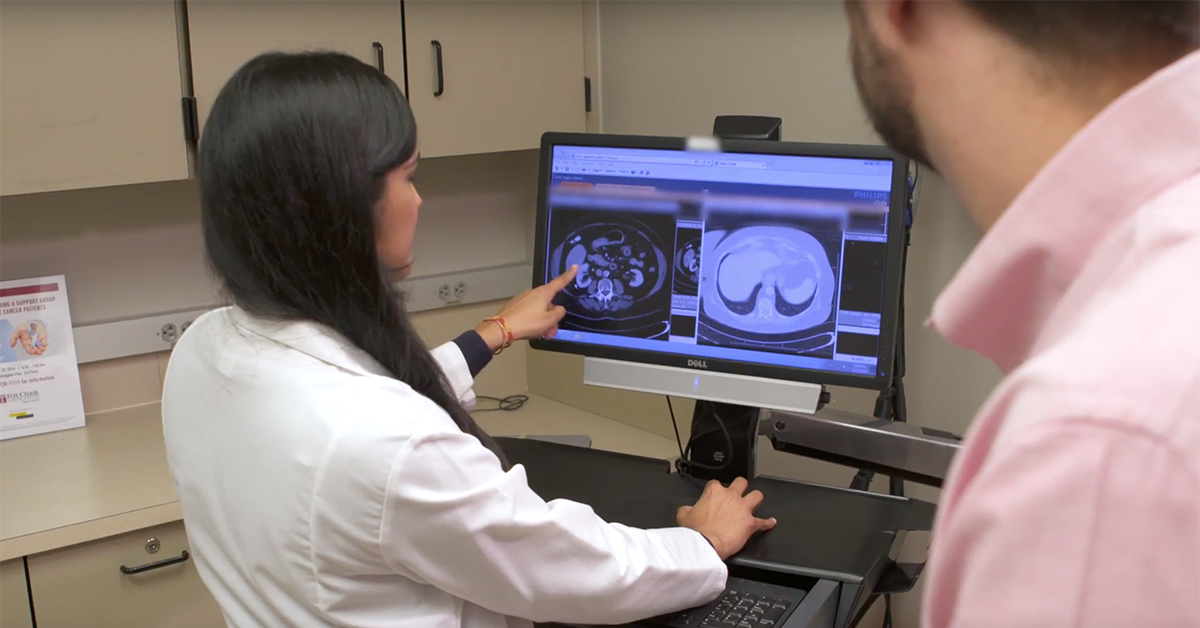
What You Need to Know about Neuroendocrine Tumors
-
Revised March 13, 2020
For people diagnosed with neuroendocrine tumors (NET), treatment has historically worked to prevent advancement of the disease, but there were no therapies available that actually shrunk these tumors – until now.
Some types of this rare form of cancer arising in neuroendocrine cells located through the body, are now being treated with a new radiation-based medication that is showing remarkable effectiveness in shrinking NETs, even if they’ve spread to other areas.
In January 2018, the Food and Drug Administration (FDA) approved the use of Lutathera (lutetium Lu177 dotatate) in adults for slow-growing NETs that have spread (metastasized) to other locations. In clinical trials over the past two years, patients receiving treatment with Lutathera showed significant reduction of the disease. Today, Lutathera is an FDA approved first-line therapy, and Fox Chase Cancer Center was one of the first centers to offer it to patients.
About Neuroendocrine Tumors
Neuroendocrine tumors are abnormal growths that develop in neuroendocrine cells, which are found throughout the body. They have characteristics of both nerve cells and hormone-producing endocrine cells. The tumors originate most often in organs in the gastrointestinal tract, the pancreas, and the lungs but can occur anywhere in the body. As they grow, the tumors can produce higher than normal levels of hormones that may cause symptoms such as flushing, severe diarrhea, or an asthma episode, or they may remain clinically silent for years.
Overall, it is estimated that more than 12,000 people in the United States are diagnosed with a neuroendocrine tumor each year and more than 165,000 patients are living with the disease each year.
The typical NET patient is a man or woman in their 50s-70s who has a long-standing history of NETs, which typically originate in the small bowel or pancreas. By the time it is discovered, the disease has usually spread (metastasized) to the liver and lymph nodes, and the cancer is not curable with surgery or any other treatment.
Diagnosis and treatment of Neuroendocrine Tumors
Neuroendocrine tumors are difficult to diagnose because they can develop anywhere in the body and behave differently based on where they grow, causing symptoms that are similar to a host of other diseases.
In addition, NETs are usually small, have a low metabolic rate, and can be located anywhere in the body, making it difficult to find them with conventional imaging techniques such as CT, FDG-PET, MRI, and ultrasound imaging.
However, a new scanning technique called Gallium68 PET/CT imaging (NETSPOT®) has made it easier to find these tumors.
After the patient is given the Gallium68 medication, radiologists take a series of CT and PET scans. The CT images show body structure and the PET captures images of organs and tissues. When the hundreds of PET and CT images are combined into a full body scan, doctors can see the NETs wherever they are because the Gallium68 connects to somatostatin receptors (SSRs) on neuroendocrine tumors. The radioactive Gallium68 decays quickly and does not stay in the body long.
Fox Chase was the first regional facility to offer this diagnostic tool and remains one of the few in the region to offer it. The PET/CT scan helps Fox Chase’s multidisciplinary team assess whether surgical removal of any of the tumors is warranted, especially in cases where the cancer is causing blockages.
Also, tumors identified with this NETSPOT® scan qualify for Lutathera treatment, a medication approved by the FDA for gastrointestinal neuroendocrine tumors that delivers a short-lived dose of radiation directly to the tumor cells using the same receptors detected by the Gallium68. As a result, the radiotherapy causes the tumors to shrink as their cells die.
Prior to the approval of Lutathera, the only treatment for NET patients with extensive disease and slow growing tumors were long acting octreotide analogs (Sandostatin and Somatuline (octreotide acetate) and everolimus in some cases. Octreotide analogs reduced symptoms for 30-70 percent of patients by inhibiting hormone production by the tumor(s) but there was little or no effect on tumor size.
By contrast, the phase 3 study using Lutathera® showed a 79 percent reduction in risk of disease progression or death with Lutathera combined with 30 mg Sandostatin LAR, compared to 60 mg Sandostatin LAR.
Learn more about neuroendocrine tumor treatment at Fox Chase Cancer Center.
